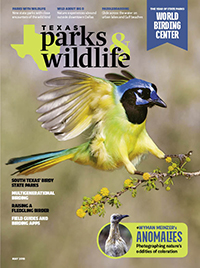
Picture This: Think Shallow
Use of selective focus brings special attention to the subject of a photograph.
By Earl Nottingham
Traditionally, one of the hallmarks of a successful outdoor photograph is the attention paid to rendering a scene’s objects in tack-sharp focus in the foreground, middle ground and background. This style adds to the perceived realism and sense of place of most scenes and is what you typically find gracing calendars and posters.
Successfully getting a wide range of objects in focus relies on a wide depth of field, which ensures that objects from very close up to very far away will be sharp. A wide depth of field is obtained by using a very small lens opening (called aperture or f/stop) such as f/16 or f/22, which can be set either manually or with several of the “Auto” functions of many point-and-shoot cameras.
However, one of the more underutilized and creative approaches to outdoor photography — which extends to landscape, nature, wildlife and even portraiture — is the exact opposite of the wide depth of field technique. It is the use of selective focus in the photograph.
Unlike a wide depth of field, selective focus is totally dependent on a very shallow depth of field using a lens’s widest available aperture.

Selective focus allows the photographer to isolate a few flowers in sharp focus while rendering those in the foreground and background in softer focus, thus adding an artistic quality.
Isolating a subject in an image by keeping it sharp while placing other distracting objects out of focus is one way to grab the viewer’s eye and call attention to important and nuanced details of that subject. Selective focus photographs can let us see ordinary objects in an extraordinary way and can add variety to any personal photo collection.
Be forewarned that a shallow depth of field, especially on a close-up/macro shot with a wide-open aperture, is a slippery slope requiring extra care to ensure that enough of the main subject is in focus considering the extremely limited focus range.
Without getting into the relationship between aperture, shutter speed and ISO (and their combined effect on the overall exposure of a photograph), suffice it to say that anytime we either manually or automatically change the aperture for creative purposes, a corresponding change must be made in the shutter speed (or ISO) to give us the same equivalent exposure. This generally means that when we select a wide aperture for a shallow depth of field, more light is entering the lens, and we must compensate for that by using a faster shutter speed. Luckily for those who are not into using manual camera settings, automatic settings can take care of this.
Here are some techniques you can use to get the best selective focus image: Aperture priority: This automatic setting on most cameras enables you to choose the aperture you want to shoot at and then calculates the appropriate shutter speed. Go ahead and select the widest aperture your particular lens will open up to. Typically, non-zoom lenses will have wider available apertures such as f/1.8 to f/2.8, which are ideal. Most lenses, by design, have a “sweet spot” and will perform better when closed down slightly from their widest opening. Portrait icon: Simpler cameras employ a “Portrait” icon with a face on the command dial, which, in essence, tells the camera that you are shooting portraits of people and would like everything, except the subject, slightly out of focus so as not to distract. It selects a wider aperture to accomplish this. Longer focal length: A lens of a shorter focal length will create greater depth of field than longer focal lengths. For instance, a 28mm lens has more depth of field than a 105mm lens when shot at the same distance from the subject. As a result, longer lenses typically work better for selective focus shots. The longer focal length will further isolate your subject by narrowing the angle of the lens’s coverage. One of my favorite lenses for selective focus shots is a 70-200 zoom shot at f/2.8. Subject positioning: Moving a subject away from a background or foreground allows more distance for focus to fall off and helps control those distracting backgrounds. |
» Like this story? If you enjoy reading articles like this, subscribe to Texas Parks & Wildlife magazine.
Related stories
Picture This: Accentuate the Negative
Picture This: Finding a New Angle
Picture This: Tips for Better Smartphone Videos
Picture This: Ambassador with a Camera
Picture This: Chasing Rainbows
Picture This: Shooting in Winter
Picture This: The Gift of Optics
Picture This: Using Scale in Landscapes
Picture This: Highlights and Shadows
Picture This: The Exposure Triangle
Picture This: Getting Exposure Right
Picture This: The New Crop of Cameras
Picture This: Kids and Cameras
Picture This: Gifts for Shutterbugs
Picture This: Video for Everyone
Picture This: Shooting Fall Color
Picture This: The Art of Seeing
Picture This: The Rule of Thirds
Picture This: Sensors and Sensitivity
Picture This: There's an App for That
Picture This: Photo Contest Winners
For more on TP&W magazine photography, go to our Photography page

